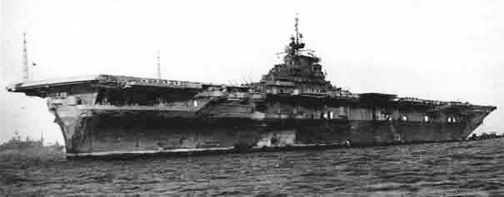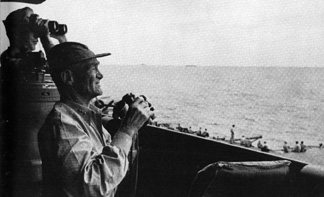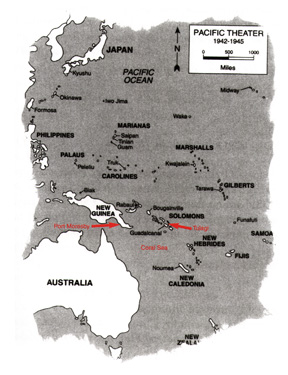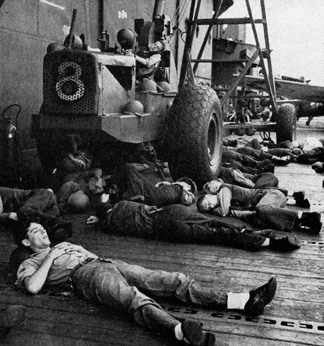|
U.S. Naval Aviation In the South Pacific during WW II Featuring the Lexington Aircraft Carrier The Battle of the Marianas — June 1944 Chapter 1 Page 2 of 7 Pages |
||||||||||||
 |
||||||||||||
|
This statement borrowed from The Warren McLellan Story Photo ctsy. Pat Cannon Vido Coll. “There have been five United States ships named USS Lexington. The 4th Lexington, an aircraft carrier, was sunk early in WWII. In 1942, in the Coral Sea during the Guadalcanal, Bougainville, Solomon Islands and Rabaul battles. When the USS Lexington was sunk in the Coral Sea, the shipyard in Boston was building another Essex type carrier. It had another name but the shipyard workers wanted another USS Lexington in the Pacific Fleet to confuse "Tokyo Rose," the propagandist for Japan during World War II. She reported the Lexington sunk several times. So, the nickname of the Lexington was the "The Blue Ghost.’’ They got the new carrier out one year earlier than planned and the 5th USS Lexington was ready for battle. The ship’s number was 16 and the first air group aboard was Carrier Air Group 16. I was assigned orders to Torpedo Squadron 16. There was also a fighter squadron and a dive bomber squadron aboard the Lexington.” |
||||||||||||
|
|
||||||||||||
| June 9: ----- I stopped for a talk with Admiral Mitscher who spends the whole day perched on a special chair on the port or left side of his bridge, facing aft, his feet propped on the base of a compass, a green canvas cap with a huge visor pulled down over his eyes. He told me he expected Japanese plane searches to spot us on either D-minus-5 or D-minus-4 and that thereafter we would have to fight our way in. The admiral seemed pleased rather than otherwise by this prospect. ----- |
||||||||||||
 |
||||||||||||
|
Ctsy: Life Mag., dated 6/17/44 |
||||||||||||
| ---- Mitscher, like many of the greatest U.S. naval heroes, comes from far inland. He was born in Hillsboro, Wisconsin, went to Annapolis in 1906 and got into naval aviation in 1916 at 29. He passed the first two years of World War II in Washington as assistant chief of the Bureau of Aeronautics under his old friend Jack Towers, now Nimitz’ deputy. Just before Pearl Harbor, however, Mitscher was put in command of the Hornet, which he commanded with celebrated skill in the Tokyo raid and at the battle of Midway. After Midway, Mitscher, by this time a rear admiral, was put in command of all aircraft in the Solomon Islands. When U.S. air supremacy in the Solomons had been completely established, he was relieved and given his present job, that of running Task Force 58, which is currently the kingpin in Central Pacific strategy. ---- |
||||||||||||
| June 10: -----The strange sights and sounds on a carrier would tax the talents of a modern Melville [First Lord of the Admiralty]. The former include: deck crews dressed in bright linen helmets and gloves, called “flash clothes” and intended to ward off burns from sudden explosions; carafes of excellent coffee, always hot, on the wardroom buffet; the hangar deck, a vast dim area full of planes with folded wings, bits of rope, dozing deck hands and the smell of oil; bombs being wheeled about in little one-handled barrows; drawings of a gun crew made by one of its members. The sounds, which suggest life inside a bass drum, include a buzz followed by a loud thump which, below decks, indicates that a plane is being launched by catapult; the deafening roar made by a planes being launched by usual procedure; the hoarse yapping in flag plot of radio conversations with other ships; and the strange admonishments which issue from the ship’s amplifier. |
||||||||||||
 |
||||||||||||
|
Map ctsy. of LPHOWWII |
||||||||||||
| Through this, at the most unlikely moments, the boatswain’s pipe or whistle suddenly screeches and a stern voice says things like: “Turn to,” or “Sweepers, man your brooms; clean sweep down, fore and aft!” or “The smoking lamp is out throughout the ship while the gasoline system is in operation.” I was told that the term “smoking lamp” is an old Navy tradition. The Navy seems inordinately proud of traditions, even new ones.
June 11: The great event of today was something called variously “Plan Johnny” or “Plan Gus.” The Navy’s ebullient young ace dive-bomber pilot, Commander Gus Widhelm, is Mitcher’s operations officer; he also has a deputy, Lieut. Commander Johnny Myers. |
||||||||||||
 |
||||||||||||
|
Ctsy: Life Mag., dated 6/17/44 |
||||||||||||
| Plans for operations and indeed everything else in the navy have to have code names; ships, for example, have code names like Furnace, Darby, Iroquois, Twenty Grand. Consequently, when Myers and Widhelm worked out a plan they naturally christened it after themselves.
Briefly described, “Plan Johnny,” to which “Plan Gus” is an addendum, is as follows: instead of going over Saipan to strafe and bomb the airstrips tomorrow at dawn, our first strike will go in at dusk tonight. To an armchair strategist this might seem a trifling departure from schedule. In fact it is quite a major one. It involves, for one thing, a nice equation in speed and fuel consumption so as to reach the environs of Saipan far enough ahead of the timetable to put it into effect. For another it means that although the Japanese searches were almost sure to have sighted us today, we might still catch their planes on the ground since they may assume that we are too far out to launch an attack till tomorrow. Chapter 1— End of Page 2 of 7 Pages — Go to Page 3 Page —1 — 2 — 3 — 4 — 5 — 6 — 7 Or This Story’s Cover Page — Editor’s Introduction — Table of Contents Fred Gwynn’s “Torpedo 16” — Chapter — 1 — 2 — 3 — 4 Or Home - Contact Us - Cold War Hist. - 91st SRS Hist. - Stardust 40 Mission Story |
||||||||||||